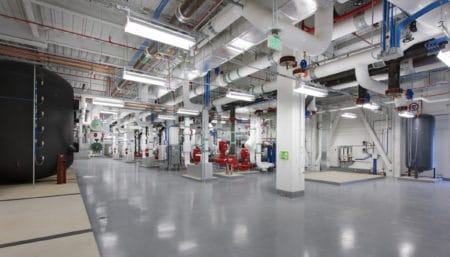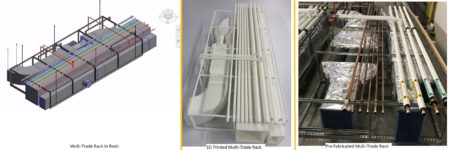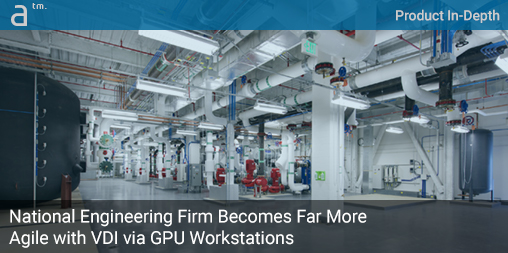ONBOARDING A NEW ARCHITECT, ENGINEER OR OTHER workstation-based CAD or BIM professional takes time and expense. Some may say it is just the cost of doing business. But when Southland Industries, an enterprise-sized engineering firm headquartered in Garden Grove, California, decided to implement “virtual desktop infrastructure” (VDI) with GPU acceleration, the company was seeking out a way to solve core challenges any large AEC firm would have working across vast geographies and offices.
“For our engineers and detailers to handle their workloads they needed to be local,” says Israel Sumano, senior director of infrastructure at Southland Industries, a design-build MEP firm that also does fire suppression. Sumano is making the case that proximity to construction sites is hugely beneficial for not just a design-build MEP firm but any firm. “Being able to go directly into the field to observe a situation or problem has great advantages,” he says.
VDI + GPU As The New Agility
Before implementing a VDI solution from Workspot, Southland would spend considerable money on deploying IT infrastructure for even just a couple of MEP engineers. “Not long ago we found talent in Chicago for a project and needed to spend $150,000 for deployment infrastructure just for the two of them,” says Sumano. “It would have cost the same if they were ten of them, but we had to put in the infrastructure for just two of them.”

Confidential Data Center, Maryland. Mechanical room for a large data center. (Image: Jeffrey Sauers / Architosh. All rights reserved.)
That infrastructure required the expense of powerful workstation-class computers, multiple 30-inch displays, but the large expense was the powerful server, local network, and its cost of connection to the Internet. They needed a server and connection that could store and replicate large CAD and BIM files, sometimes as large as 40 gigabytes.
“Before we went to VDI we were replicating 50 terabytes in real-time to 17 different locations across the country,” adds Sumano, “and the hardware needed to support that kind of workload is what the expense is.”
Workspot’s Cloud VDI and GPU workstations have given Southland Industries greater agility as a company. This means they can recruit and hire the best talent from just about anywhere as well as onboard new employees faster through a virtualized desktop experience. “In the past, there was a lot of work that went into getting a machine ready for a new user,” says Sumano. “We put processes in place so that everyone who is using these VDI solutions is using the same footprint across the company. We have a master image, and all we have to do is turn on a machine and that user is ready to go.”
Southland’s VDI + GPU Solution
Southland, as one of the country’s largest MEP+F design-build firms, has over 2000 users across engineering, CAD, and BIM roles, including managers. “We do very large projects across the United States,” says Sumano, “for example, we rebuilt the Pentagon after 911.”
Their typical engineer or detailer is running the Autodesk AEC suite of tools, with heavy usage of Revit, AutoCAD, and Navisworks. While some tasks are still best handled in 2D CAD, the majority of their work is done in BIM (Building Information Modeling) applications. The Autodesk suite of tools is installed in every VDI instance.
When we open the same model from the VDI instance in Azure it opens within five minutes, because the data links between Azure and Collaboration for Revit (C4R) are much bigger than they are at the job site.
By having a virtualized desktop environment, their staff can access BIM models that are upwards of 40 GBs far quicker on a day to day basis using the VDI solution from Workspot. The actual files for the company live on Microsoft Azure’s cloud. Revit Server also runs on Azure, and all of this is accessed through the VDI client software from Workspot. Revit models may exist in C4R (Collaboration for Revit). Before Workspot’s VDI solution just replicating a large BIM model to a local engineer’s workstation could take an hour to cache. “When we open the same model from the VDI instance in Azure it opens within five minutes,” says Sumano, “because the data links between Azure and Collaboration for Revit (C4R) are much bigger than they are at the job site.”

Image showing Revit modeling of MEP systems typical of the work involved in Southland Industries projects. (image: Southland Industries / Architosh. All rights reserved.)
Sumano is making the point that up in the cloud the data pipes between major cloud providers like Microsoft Azure and Autodesk’s cloud tools and apps are enormous compared to the bandwidth-constrained pipes common to the last mile that a remote office or job site may have. “Even for native cloud apps like C4R,” adds Sumano, “the modeling and models perform better when they are all in the cloud.”
Southland Industries tried two to three VDI solutions for about five years before settling on Workspot. They even tried building their own VDI infrastructure at one point in time. “We finally tested Workspot last year for six months and went live last fall,” adds Sumano, who is experienced with installing VDI solutions from other vendors like Citrix.
Southland needed capable GPU performance, and this was something the virtualized environment with Workspot and Azure provided. In other solutions they tested, the GPU was often shared between users. “But with the Azure solution there is a dedicated GPU per user,” he adds.
Looking Down the Road
Sumano says that the company is very happy with the agility the VDI solution from Workspot provides. While the various costs are now in different buckets, the greater agility a successful VDI solution provides is going to start hitting the bottom line soon. While he acknowledges that the AEC industry is slow to adopt technology change, he advises that change management is always a critical step to deploying a system like VDI + GPU.




Reader Comments
Comments for this story are closed